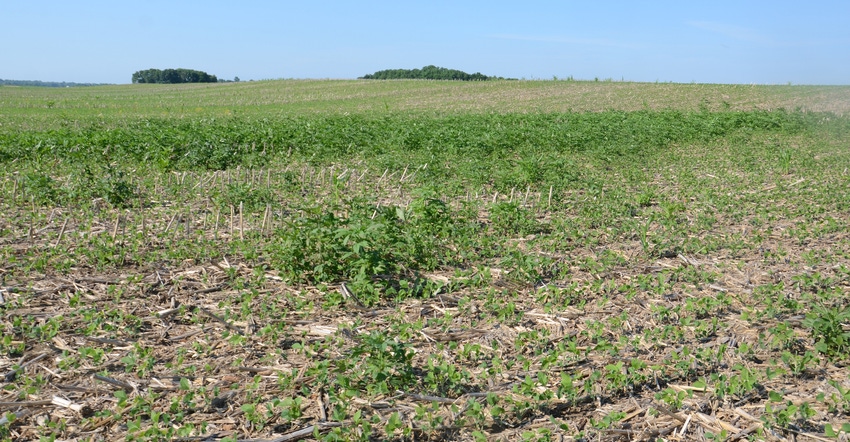
The grower who drove his sprayer over the hill and found patches of giant ragweed in the no-till soybean field pictured here was disappointed. His soil residual herbicides didn’t stop ragweed from escaping. He figured it was time to change up his soil residual herbicide lineup for 2021.
Bill Johnson has a different viewpoint. “If his current soil-applied residual program is working on everything else, changing it may not be the answer,” says the Purdue University Extension weed control specialist. “We currently don’t have good solutions for giant ragweed control with residual herbicides in soybeans.
“If giant ragweed is a problem, you may need to be ready to take it out with postemergence applications. If you know that ahead of time, you can spray earlier and catch giant ragweed while they are smaller. Then spray applications should be more effective.”
If you do come across patches with giant ragweed as large as those pictured here, Roundup plus Flexstar may be your best option to burn them back, Johnson says. If they are Xtend or XtendFlex soybeans with dicamba tolerance, then a dicamba product would be an option. If they’re Enlist E3 soybeans, 2,4-D choline becomes an option. Liberty could be used as well in soybeans that have the LibertyLink trait.
Other postemergence options
The best bet is to assume giant ragweed is glyphosate-resistant, Johnson says. Some are also resistant to ALS herbicides such as FirstRate and Classic. “You really need to be able to spray Liberty, 2,4-D choline or dicamba post in soybeans for effective giant ragweed control,” he explains.
If you planted Enlist 3 soybeans, you can spray 2,4-D choline or Liberty or both. With LibertyLink or LLGT27 soybeans, you can spray Liberty, and with XtendFlex beans, you can spray Liberty or dicamba. If you have Xtend beans, you can spray dicamba, but if you have Roundup Ready 2 beans, you are limited to glyphosate plus other herbicides that work on conventional soybeans.
Set the stage
Controlling giant ragweed in corn is easier because there are several good soil-applied, residual herbicide options, Johnson says. For example, you could choose any of the atrazine premixes. He would consider adding Balance, Callisto or Hornet. You could also choose Acuron or a SureStart/TripleFlex product, which is a mix of acetochlor and the active ingredients in Hornet.
You can come back postemergence with dicamba in corn. Status or a generic equivalent would be an option. Remember, volatility is an issue, so avoid spraying at high temperatures.
“What we find with giant ragweed is it tends to be a bigger problem today for people in rotational tillage,” Johnson says. “If you no-till soybeans but then till ahead of corn, you continuously bring giant ragweed seed to the surface. If you no-till every year, the large seed tends to deteriorate on top. If you till every year, you keep burying it. So, in continuous no-till or continuous conventional till, it’s less of a problem.”
If you’re growing conventional, non-GMO soybeans, you’re limited to conventional chemistry. Making matters worse, both ALS-resistant and PPO-resistant ragweed could be an issue.
What if you have common ragweed, too? Johnson says the same programs that work for giant ragweed should work for common ragweed.
About the Author(s)
You May Also Like




